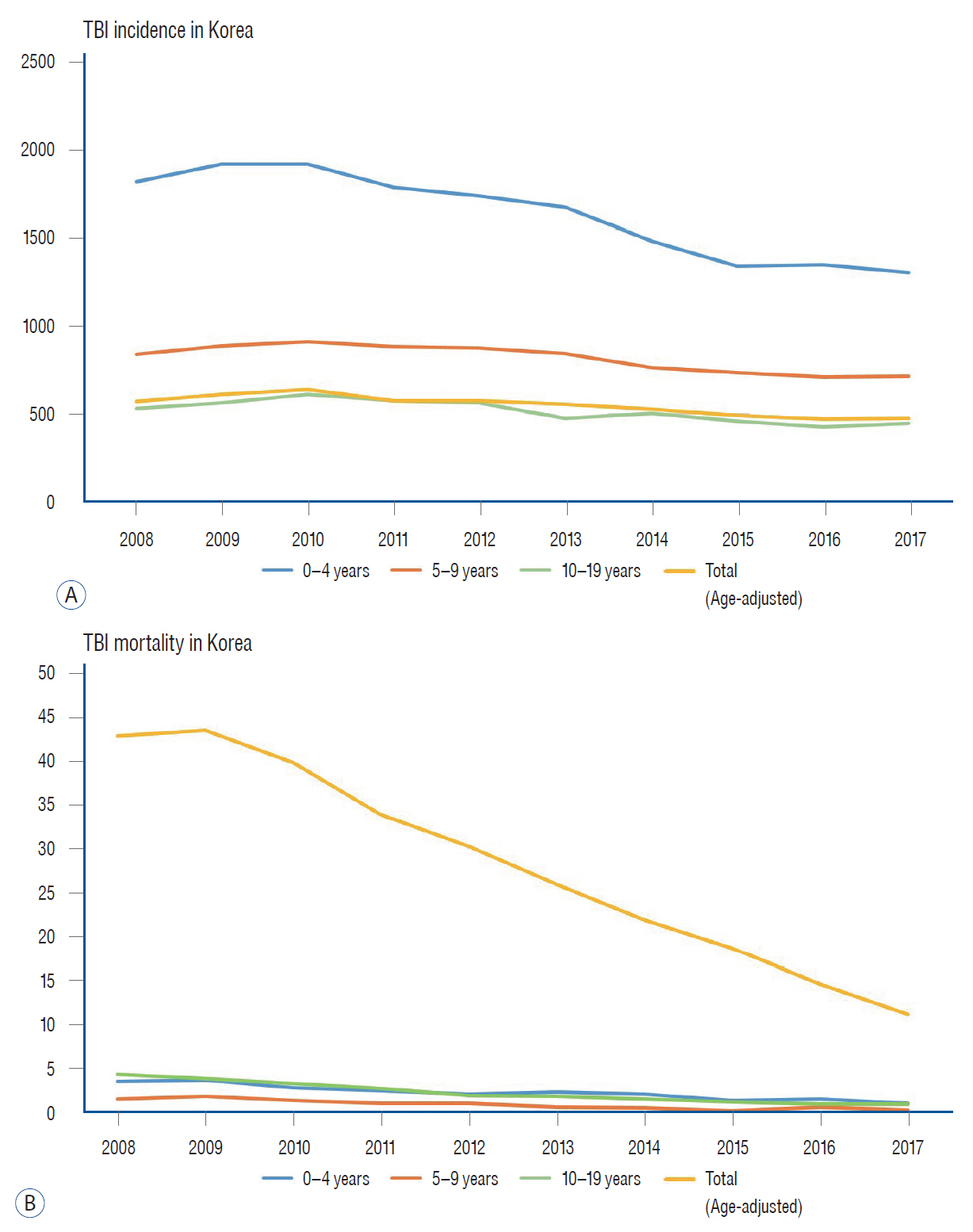J Korean Neurosurg Soc.
2022 May;65(3):334-341. 10.3340/jkns.2021.0306.
Pediatric Traumatic Brain Injury : The Epidemiology in Korea
- Affiliations
-
- 1Department of Neurosurgery, Ulsan University Hospital, University of Ulsan College of Medicine, Ulsan, Korea
- 2Department of Neurology, Ulsan University Hospital, University of Ulsan College of Medicine, Ulsan, Korea
- KMID: 2529576
- DOI: http://doi.org/10.3340/jkns.2021.0306
Abstract
- Traumatic brain injury (TBI) is one of the leading causes of death in the pediatric population in Korea. In addition, it can cause disability in children and adolescents, with physical and mental consequences. This causes a substantial burden on the health care system and occurs globally and not just in Korea. We searched and reviewed current data on the epidemiologic characteristics of pediatric TBI in Korea. Our review provides the recent epidemiological trend mainly focusing on incidence and mortality along with worldwide reported data. This review will be helpful to understand the global epidemiology of pediatric TBI and its differences between countries.
Keyword
Figure
Reference
-
References
1. Araki T, Yokota H, Morita A. Pediatric traumatic brain injury: characteristic features, diagnosis, and management. Neurol Med Chir (Tokyo). 57:82–93. 2017.
Article2. Avraham JB, Bhandari M, Frangos SG, Levine DA, Tunik MG, DiMaggio CJ. Epidemiology of paediatric trauma presenting to US emergency departments: 2006-2012. Inj Prev. 25:136–143. 2019.
Article3. Brazinova A, Rehorcikova V, Taylor MS, Buckova V, Majdan M, Psota M, et al. Epidemiology of traumatic brain injury in Europe: a living systematic review. J Neurotrauma. 38:1411–1440. 2021.
Article4. Cheng P, Yin P, Ning P, Wang L, Cheng X, Liu Y, et al. Trends in traumatic brain injury mortality in China, 2006-2013: a population-based longitudinal study. PLoS Med. 14:e1002332. 2017.
Article5. Dewan MC, Mummareddy N, Wellons JC 3rd, Bonfield CM. Epidemiology of global pediatric traumatic brain injury: qualitative review. World Neurosurg. 91:497–509.e1. 2016.
Article6. Eapen BC, Allred DB, O'Rourke J, Cifu DX. Rehabilitation of moderate-to-severe traumatic brain injury. Semin Neurol. 35:e1–e3. 2015.
Article7. Eisele JA, Kegler SR, Trent RB, Coronado VG. Nonfatal traumatic brain injury-related hospitalization in very young children-15 states, 1999. J Head Trauma Rehabil. 21:537–543. 2006.
Article8. Feigin VL, Theadom A, Barker-Collo S, Starkey NJ, McPherson K, Kahan M, et al. Incidence of traumatic brain injury in New Zealand: a population-based study. Lancet Neurol. 12:53–64. 2013.
Article9. Figaji AA. Anatomical and physiological differences between children and adults relevant to traumatic brain injury and the implications for clinical assessment and care. Front Neurol. 8:685. 2017.
Article10. Goldsmith W, Plunkett J. A biomechanical analysis of the causes of traumatic brain injury in infants and children. Am J Forensic Med Pathol. 25:89–100. 2004.
Article11. Hsu IL, Li CY, Chu DC, Chien LC. An epidemiological analysis of head injuries in Taiwan. Int J Environ Res Public Health. 15:2457. 2018.
Article12. Jeong HW, Choi SW, Youm JY, Lim JW, Kwon HJ, Song SH. Mortality and epidemiology in 256 cases of pediatric traumatic brain injury: Korean Neuro-Trauma Data Bank System (KNTDBS) 2010-2014. J Korean Neurosurg Soc. 60:710–716. 2017.
Article13. Kim HB, Kim DK, Kwak YH, Shin SD, Song KJ, Lee SC, et al. Epidemiology of traumatic head injury in Korean children. J Korean Med Sci. 27:437–442. 2012.
Article14. Kim HK, Leigh JH, Lee YS, Choi Y, Kim Y, Kim JE, et al. Decreasing incidence and mortality in traumatic brain injury in Korea, 2008-2017: a population-based longitudinal study. Int J Environ Res Public Health. 17:6197. 2020.
Article15. Korean Statistical Information Service : Causes of Death Statistics in 2020. Available at : http://kostat.go.kr/portal/eng/pressReleases/8/10/index.board?bmode=read&bSeq=&aSeq=414516&pageNo=1&rowNum=10&navCount=10&currPg=&searchInfo=&sTarget=title&sTxt=.16. Li L, Liu J. The effect of pediatric traumatic brain injury on behavioral outcomes: a systematic review. Dev Med Child Neurol. 55:37–45. 2013.
Article17. Taylor CA, Bell JM, Breiding MJ, Xu L. Traumatic brain injury-related emergency department visits, hospitalizations, and deaths - United States, 2007 and 2013. MMWR Surveill Summ. 66:1–16. 2017.
Article18. Theadom AFV, Reith CMF, Maas IR. Andrew epidemiology of traumatic brain injury in Winn H (ed) : Youmans and Winn Neurological Surgery. Philadelphia: Elsevier;2017. p. 2748–2754.19. Theodorou CM, Galganski LA, Jurkovich GJ, Farmer DL, Hirose S, Stephenson JT, et al. Causes of early mortality in pediatric trauma patients. J Trauma Acute Care Surg. 90:574–581. 2021.
Article20. Thurman DJ. The epidemiology of traumatic brain injury in children and youths: a review of research since 1990. J Child Neurol. 31:20–27. 2016.
Article
- Full Text Links
- Actions
-
Cited
- CITED
-
- Close
- Share
- Similar articles
-
- Pediatric Minor Traumatic Brain Injury : Growing Skull Fracture, Traumatic Cerebrospinal Fluid Leakage, Concussion
- Movement Disorders after Traumatic Brain Injury
- Traumatic Brain injury and Sleep Disorder
- Animal Models of Traumatic Brain Injury
- Pediatric Severe Traumatic Brain Injury : Updated Management


